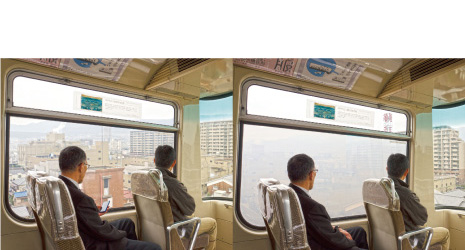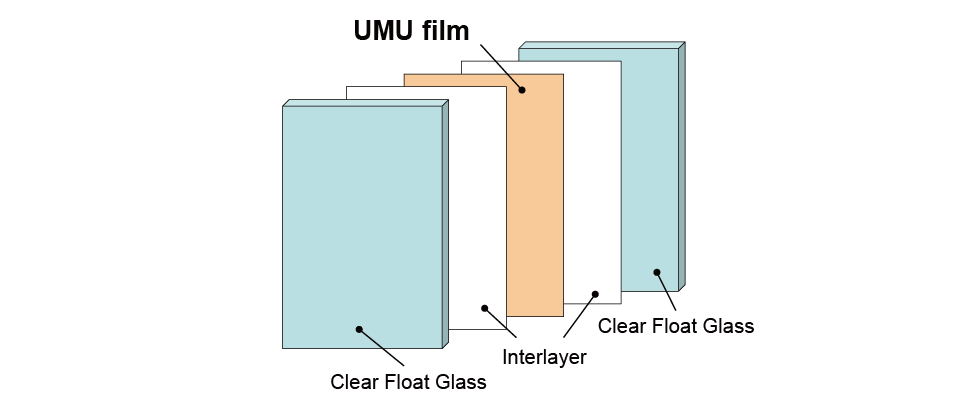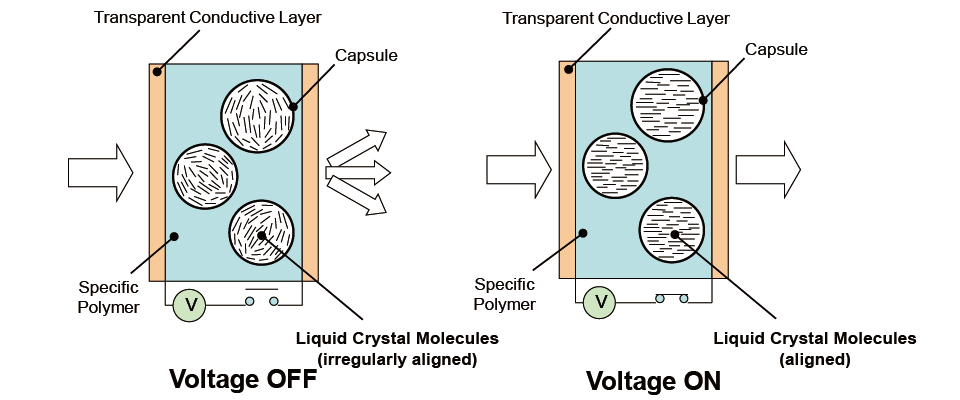November 2022
Glass That Can Be Switched from Transparent to Opaque on Demand

Train window using UMU. When the train passes near residential areas, the window automatically becomes opaque, protecting the privacy of those living near the tracks. -

Conference room partition using UMU

A Japanese company is continuing to improve its switchable light control glass, and applications for the glass are expanding.

Light control glass is a type of glass that can instantly switch between being transparent and being opaque by turning electricity on or off. For example, it can offer the convenience of being able to see whether a restroom in a hotel or home is vacant while also ensuring privacy while in use. If used as a partition in a conference room, it allows for an office space with a sense of openness by being set to transparent when not in use.
Nippon Sheet Glass Company, Ltd. is one of the companies leading the world in research and development of this light control glass. They developed UMU, a type of switchable light control glass, in 1987.
UMU is made up of laminated glass which sandwiches a transparent film (UMU film), which is dispersed capsules that are a few microns in diameter containing liquid crystal* molecules, between an intermediate membrane of resin, and is then further laminated by two sheets of float glass** (see Figure 1). The liquid crystal molecules are normally irregularly aligned along the inner walls of the capsules, but when voltage is applied, they align themselves in a certain direction. When the molecules are irregularly aligned within the capsules, the light that hits them is scattered, and the film is opaque (a milky white color), but when they become aligned, light can pass through without scattering and the film becomes transparent (see Figure 2).
Yano Yuichi, Technical Director of NSG UMU Products Co., Ltd.*** in Ichihara City, Chiba Prefecture, a company that has worked on research and development of UMU for over 30 years, explains, “The amount of light passing through the UMU film is actually almost the same, whether transparent or opaque. The difference is in whether the light passes in parallel or is scattered. Clouds, which are a visible mass of transparent water particles, look white because the water particles scatter the light, and the same thing happens with UMU film.”
When UMU, which could become transparent or opaque instantly, was first released in 1987, it attracted a great deal of attention from the marketplace. But the path to its successful development had been filled with difficulties. Laminated glass is produced by fixing two pieces of glass together with high heat or pressure. But the liquid crystals found in UMU film are sensitive to heat and pressure. This meant that a major issue was in figuring out how to minimize the effects on the UMU film when fixing the glass together. It was also difficult to create large-sized UMU film with uniform quality.
Overcoming all of these issues, the company completed UMU. In the early years of production, it was mainly used in offices, hotels, and other buildings due to its durability and cost, but later, as quality and cost improved, it became possible to use it in a variety of other places, such as in partitions between front and back seats in luxury cars and in train windows.
Yano says, “Research and development in recent years is progressing with techniques to not only switch between states of transparency and opaqueness, but also absorb and reflect the light that passes through the glass.” If we can reflect the light, it will become possible to have transparent glass instantly turn into a mirror. Light control glass will surely expand the potential of glass in the future.


UMU switchable light control glass is opaque (when no voltage is applied) UMU is transparent (when voltage is applied)
* Liquid crystals are a substance in a state between liquid and solid (crystal). They are in a transparent and viscous liquid state. The arrangement of the molecules changes through external voltage.
** Float glass is a sheet of glass made using the float glass process, where glass is made by having melted glass “float” over melted tin.
*** Founded by Nippon Sheet Glass Co., Ltd. in 1997 as a company handling the manufacturing and sales of UMU

